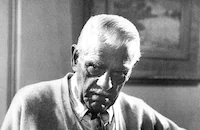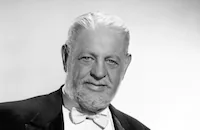The Black Room
Brief Synopsis
Cast & Crew
R. William Neill
Boris Karloff
Marian Marsh
Robert Allen
Thurston Hall
Katherine De Mille
Film Details
Technical Specs

Synopsis
In a Tyrolean castle at the end of the 19th century, twins, Gregor and Anton, are born to the Baron de Berghman. Legend has it that when twins are born to the de Berghman family, the younger twin will kill the older one, so Anton, the youngest, is sent away to prevent a tragedy. Twenty years later, Gregor, who has been left to rule in Anton's absence, requests Anton's return. The town is suspicious of Gregor after several people disappear mysteriously from the castle. Gregor now announces plans to divide the responsibilities of ruling with his brother, but Anton has heard rumors of the disappearances and is wary of Gregor's motives. Gregor plans to marry Thea, Colonel Hassel's daughter, and after he meets her, Anton also becomes smitten with her. Meanwhile, Gregor murders the Hassel's servant, Mashka, when she threatens to reveal their affair. Peter, a palace servant, finds Mashka's scarf and shows it to some peasants who march on the castle. With the mob threatening, Gregor renounces his title in favor of the more popular Anton. Then, Gregor shows his brother the secret entrance to the Black Room, which was used in the past as a torture chamber. Anton sees Mashka's bones in the pit, but before he can react, Gregor shoves his brother into the pit, too. Gregor then assumes Anton's role, imitating his paralyzed arm, and only Thor, Anton's mastiff, knows the truth. After Hassel appoints Gregor as Thea's guardian, he discovers the ruse but before he can expose Gregor, he is murdered. Hassel's murder is blamed on Thea's true love, Lt. Albert Lussan, and Gregor convinces her to marry him, instead. On his wedding day, Gregor, on his way to visit the Black Room, is attacked by Thor, causing him to reveal his identity. Gregor retreats to the Black Room, where the angry Thor once again attacks him, this time sending him into the pit where he is impaled on the knife that is gripped in Anton's decaying hand, thus fulfilling the prophecy and leaving Lussan free to marry Thea.

Director
R. William Neill
Cast

Boris Karloff

Marian Marsh
Robert Allen

Thurston Hall
Katherine De Mille
John Buckler

Henry Kolker
Colin Tapley
Torben Meyer
Egon Brecher
John M. Bleifer
Fredrik Vogeding

Edward Van Sloan
Lois Lindsey
Phyllis Fraser
George Burr Macannan
John Maurice Sullivan
Reginald Pasch
Robert Middlemass
Marion Lessing
George Macquarrie
Edith Kingdon
Carrie Daumery
Grace Goodall
Eric Mayne
Edwards Davis
Count Rudolf Von Stefenelli
Wilfrid North
Von
Sidney Bracy
Helena Grant
Joseph Singer
Victor Delinsky
Paul Weigel
Bert Sprotte
Michael Mark
James Gordon
Richard Lancaster
Bert Howard
Hans Von Morhart
Ivan Linow
Abe Dinovitch
Bleifer Twins
John Beck
Alexander Melesh
Enrique Acosta
Crew
Edward Bernds
Richard Cahoon
Harry Cohn
C. C. Coleman
George Denormand
Herbert Evans
Stephen Goosson
Murray Mayer
Henry Myers
Robert North
Allen G. Siegler
Louis Silvers
Arthur Strawn
Arthur Strawn

Film Details
Technical Specs

Articles
The Black Room
This is where we find Boris Karloff, in 1935. Over the preceding four years he has been a busy man, starring in no less than eight horror hits: Frankenstein (1931), The Old Dark House (1932), The Mask of Fu Manchu (1932), The Mummy (1932), The Ghoul (1933), The Black Cat (1934), and The Raven (1935). He played non-horror roles, too-but these were fewer in frequency, smaller in prestige, lesser in effect. As a horror star he was practically a brand name - Universal Studios had dismissed with the "Boris" part of that brand altogether and let "Karloff" bring in the punters. It was an arrangement that brought Karloff a healthy living and his employers a guaranteed audience, but it was limiting for an artist of gentlemanly manners and quiet grace. The trick was to step out of the make-up intensive shocker roles but not lose the stardom in the trade.
Columbia Pictures offered Karloff a single picture contract in 1935, fast on the heels of The Raven. It would be a low-budget thriller, tentatively entitled "The Black Room Mystery," that would imbue Gothic atmosphere into a period drama, aiming for a less lurid result than the increasingly horrific fare of Universal. As written by Henry Myers and Arthur Strawn, it presents the tragic tale of the accursed de Bergmann family, landed gentry in some Eastern European vagary. The film opens with a scene all but pilfered from The Bride of Frankenstein (1935), as anxious servants cluster in the great hall of the Baron's castle to attend a birth of ominous portent. The Baroness has brought forth twins, to which the killjoy Baron has screeched, "Don't toast this birth!" The de Bergmann clan was forged in an act of fratricide, as the younger twin slew his elder brother in jealousy that something so arbitrary as the order in which they sluiced down the birthing canal could separate the one who gets the family title and wealth from the one who gets squat. Ever since, the family has obsessed over the fear that this crime was fated to repeat itself-they've even gone and scribbled their paranoia into the family crest. Of course, they could just rejigger their inheritance traditions to let twins share in the glory, but that'd ruin the movie.
Twins Gregor (first) and Anton (second) both grow up to be Boris Karloff, but with different, even opposite, personalities. Anton is the quiet, sensitive type who likes flowers and poetry, and has a paralyzed right arm frozen to his chest. Baron Gregor is a drunken lout, hated by his subjects, and a serial killer to boot.
Tiring of having the Baron rape and murder their women, the villagers get their mob on and storm the castle. If the sight of torch-wielding townsfolk gives you a touch of déjà vu, well, these scenes were filmed on Universal's still-standing Frankenstein-village sets. As if remembering that being attacked by an angry mob hasn't worked out so well for him in previous films, Karloff's Gregor offers them an unexpected compromise: he summarily abdicates, leaving his brother the family business. Mollified, the crowd abates, and Gregor shows Anton where the bodies are buried. Literally. He takes him through the secret passage to the legendary "Black Room," an onyx-walled torture chamber where Gregor has dumped the bodies of the girls he's finished with. Horrified, Anton is still not sufficiently self-protective-the prophecy does say he is fated to kill Gregor, not the other way 'round. Which all makes him a sitting duck for Gregor's cruel blow. Anton lies dead at the bottom of the pit in the Black Room, and all Gregor has to do to get away with it is successfully impersonate his brother-forever, and ever and ever.
This is the point where The Black Room really starts to sparkle (the "Mystery" part was dropped from the title when somebody realized that there was no mystery in the film). Sure, it has been handsomely appointed throughout. The low-budget never impaired the ability of production designer Stephen Goosson or cinematographer Al Siegler from draping shadowy atmosphere over every corner of the frame, or director Roy William Neill from staging every detail with visual precision and cinematic style. Yet for all these artistic attributes The Black Room remains first and foremost a Karloff vehicle. Playing the twins is a nice stunt, but their wildly disparate personalities are almost comically different. Karloff's true abilities show themselves when he gets to unveil a third, more complex, characterization: Gregor-as-Anton. Instead of playing these scenes as Anton, Karloff creates a new performance that layers a simulacrum of Anton's mannerisms on top of the still-present shifty deviousness of Gregor. Karloff deftly keeps both characters in view at once, in a way no double exposure ever could.
By any measure, The Black Room is a minor film of the 1930s, remembered and enjoyed today almost exclusively because fans of Boris Karloff and of classic Gothic horror are such avid partisans. The irony is that, within those subcategories of "Boris Karloff films" and "old timey Gothic horrors," The Black Room is something of a high water mark and well-deserving of being remembered. It marked a turning point for Karloff, and the horror genre he helped popularize. The actor would remain a star, and stubbornly fixed in the mind of audiences and studio casting directors alike as a horror star, yet increasingly he would be free of the monster make-ups. Meanwhile, the growing censorial problems in England would force horror filmmakers away from the more gruesome Gothic terrors of the early 1930s and into more of the kind of amped-up melodramas like The Black Room. It is telling that director Roy William Neill would later make his best-remembered contribution to Gothic horror with 1943's Frankenstein Meets the Wolf Man, a creative disappointment that squandered numerous opportunities in one go. Neill had proven himself more than capable, but something changed in the DNA of the genre in those intervening years that robbed Frankenstein Meets the Wolf Man of the same atmospheric flourishes and cinematic confidence of the earlier film, despite having a more promising premise. Completists who tune in simply because they see The Black Room stars Boris Karloff are going to find themselves most pleasantly surprised.
Director: Roy William Neill
Screenplay: Henry Myers; Arthur Strawn (screenplay and story)
Cinematography: Allen G. Siegler
Art Direction: Stephen Goosson
Music: R.H. Bassett, Milan Roder, Louis Silvers (uncredited)
Film Editing: Richard Cahoon
Cast: Boris Karloff (Baron Gregor de Bergmann/Anton de Bergmann), Marian Marsh (Thea Hassel), Robert Allen (Lt. Albert Lussan), Thurston Hall (Col. Paul Hassel), John Buckler (Buran, the gypsy), Torben Meyer (Peter, the majordomo), Katherine DeMille (Mashka), Henry Kolker (Baron de Berghman), Colin Tapley (Paul Hassel as a young lieutenant), Edward Van Sloan (doctor), Egon Brecher (lead villager), Helena Grant (Anna, the housekeeper), Marion Lessing (Maria, the chambermaid), Robert Middlemass (prosecutor).
BW-67m.
by David Kalat
Sources:
Denis Gifford, Karloff: The Man, The Monster, The Movies
Richard Bojarski and Kenneth Beale, The Films of Boris Karloff
Paul Jensen, Boris Karloff and His Films
Gregory William Mank, Karloff and Lugosi
Bryan Senn, Golden Horrors: An Illustrated Critical Filmography, 1931-1939

The Black Room
Quotes
Trivia
Notes
This film was reviewed in Hollywood Reporter as The Black Room Mystery.















